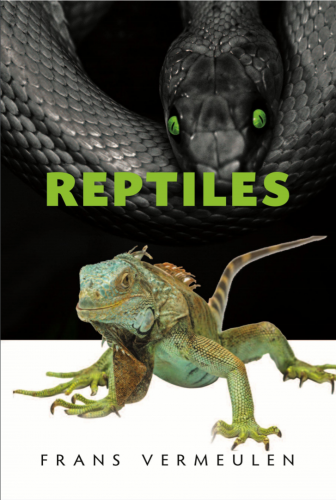A study of the Reptile remedies in homeopathy - Materia medica, Clinical manifestations, Affinities, Biological profiles and Characteristics of Colubrids, Constrictors, Crocodilians, Dinosaurs, Elapids, Lizards, Pit Vipers, Sea Snakes, True Vipers, Turtles, Worm lizards.
- Author: Frans Vermeulen
- ISBN: 9781908127358
- 680 pages
- Hardback
- Published in 2020
- Printed in United Kingdom
Reprinted with the permission of The Society of Homeopaths, (from 'The New Homeopath' Journal, Spring 2021 edition). Reviewed by Tina Burchill FSHom (Honorary).
This comprehensive book simply titled Reptiles is the latest of Frans Vermeulen’s Materia Medica collections, a solid tome with an eye-catching cover that immediately draws the reader to look inside.
This first impression is a fitting one for a work that begins in its preface with a description of the alluring nature of reptiles – fascinated or repulsed by them, we are, says Vermeulen, “mesmerised”.
While this is particularly true of the snakes, this book invites us to spread our homeopathic wings and think beyond the most commonly used of the reptile remedies Lachesis and Crotalus. Indeed it promises much – sufficient basis for the prescription of a further 60 reptile remedies as well as the 43 that have provings.
Reptiles and the human psyche
The book begins as you would expect with an overview of general reptilian traits, providing a breakdown of characteristics usefully divided into sections that includes zoological information as well as an overview of their significant place in the human psyche.
We learn many facts and some fiction, for example, reptiles aren’t cold blooded as is commonly believed, they are ectothermic - that is, they use outside energy sources to regulate their body temperature, a positive survival advantage in many environments.
Easy to navigate chapters follow, covering crocodilians, dinosaurs, lizards, snakes, turtles and tortoises, and finally worm lizards. Of course, the section on snakes is by far the largest chapter and is further broken down into family groups. Indeed, the author claims this is the only homeopathic resource that classifies snakes into their correct zoological families.
But the chapter offers much more than classifications, bringing together a wealth of information from snake legends, to serpent worship and snake metaphors, along with the different effects of snake venoms in the body and their uses in conventional medicine.
Solid basis for prescription?
While this is undoubtedly a valuable and meticulously put together resource for homeopathic practitioners, my one criticism is that I am not convinced that it lives up to its promise of offering a solid basis for the prescription of those reptiles for which there is currently no homeopathic information from provings or clinical use.
While this book includes detail from an extensive reviewing of medical articles and reports on envenomation that does provide relevant information in some cases, there are reptiles included in this book for which very little is presented. I wonder if it might have been more useful to streamline and exclude those with such limited details.
Reptiles and humans
Overall however, this book is a thoroughly comprehensive and fascinating collation of information from a wide range of disciplines, sources and cultures, offering insight not just on reptiles themselves but also on their place in the natural world and their relationship to human beings.
Tina Burchill FSHom (Honorary) is a former editor of the Society of Homeopaths journal and Newsletter, and has written widely about health and homeopathy in national magazines and newspapers. She qualified from the School of Homeopathy in 2005 and after 10 years running a busy part time practice in Leicester, she mostly retired from homeopathic practice when she moved to Devon in 2015. Since then she has trained as a wilderness rites of passage guide and gained an MA in Myth and Ecology. Her work for the Society spanned some 15 years and she was awarded a Society Fellowship in 2018 in recognition of her contribution.

